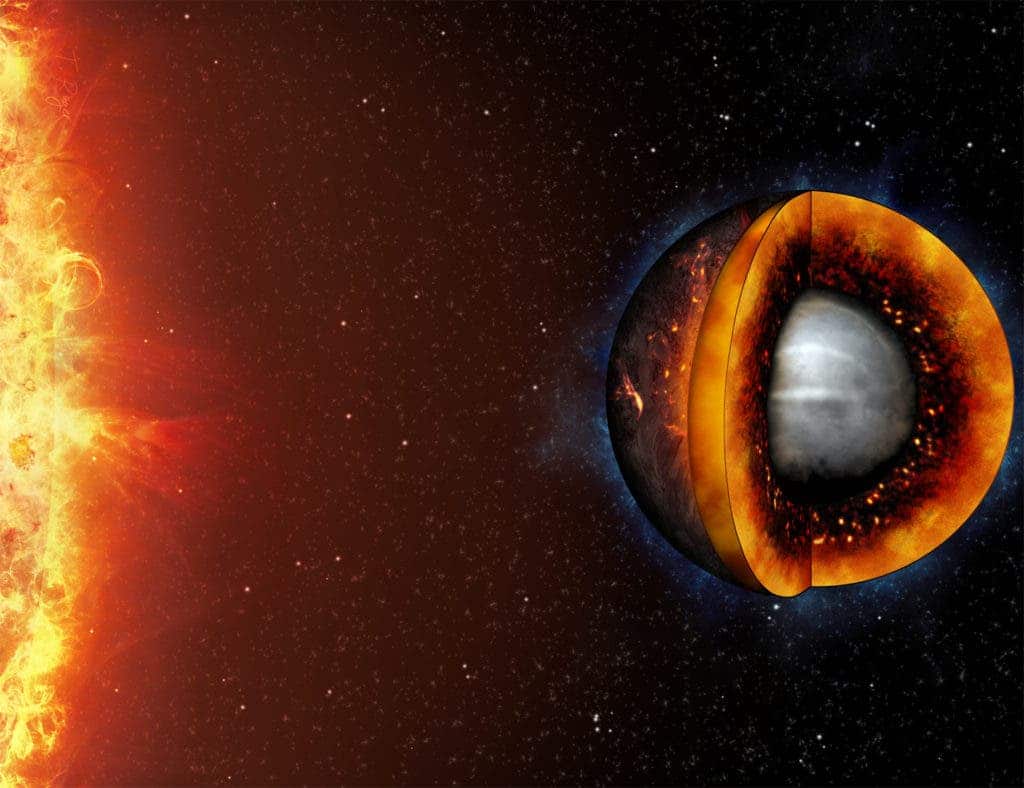
Researchers from the University of Bern have discovered that the Earth would be approximately 5% larger if it were hot and molten rather than rocky and solid. Pinpointing the difference between rocky exoplanets and their hot, molten counterparts is vital for the search for Earth-like exoplanets orbiting stars outside the solar system.
The fact that rocky exoplanets that are approximately Earth-sized are small in comparison to other planets, makes them notoriously difficult for astronomers to spot and characterise. Identification of a rocky exoplanet around a bright, Sun-like star will likely not be plausible until the launch of the PLATO mission in 2026. Thankfully, spotting Earth-size planets around cooler and smaller stars such as the red dwarfs Trappist-1 or Proxima b is currently possible.
But, searching for molten exoplanets could help astronomers probe the darkness of space — and identify Earth-sized rocky-exoplanets around stars like our own.
“A rocky planet that is hot, molten, and possibly harbouring a large, outgassed atmosphere ticks all the boxes,” says Dan Bower, an astrophysicist at the Center for Space and Habitability (CSH) of the University of Bern. “Such a planet could be more easily seen by telescopes due to strong outgoing radiation than its solid counterpart.”
Learning more about these hot, molten worlds could also teach astronomers and astrophysicists more about how planets such as our’s form. This is because rocky planets such as the Earth are built from ‘leftovers of leftovers’ — material not utilised in either the formation of stars or giant planets.
“Everything that doesn’t make its way into the central star or a giant planet has the potential to end up forming a much smaller terrestrial planet,” says Bower: “We have reason to believe that processes occurring during the baby years of a planet’s life are fundamental in determining its life path.”
This drove Bower and a team of colleagues mostly from within the Planet S network to attempt to discover the observable characteristics of such a planet. The resulting study — published in the journal Astronomy and Astrophysics — shows that a molten Earth would have a radius 5% or so larger than the actual solid counterpart. They believe this disparity in size is a result of the differences in behaviour between solid and molten materials under the extreme conditions generated beneath the planet’s surface.
As Bower explains: “In essence, a molten silicate occupies more volume than its equivalent solid, and this increases the size of the planet.”

This 5% difference in radii is something that can currently be measured, and future advances such as the space telescope CHEOPS — launching later this year — should make this even easier.
In fact, the most recent collection of exoplanet data suggests that low-mass molten planets, sustained by intense starlight, may already be present in the exoplanet catalogue. Some of these planets may well then be similar to Earth in regards to the material from which they are formed — with the variation in size no more than the result of the different ratios of solid and molten rock.
Bower explains: They do not necessarily need to be made of exotic light materials to explain the data.”
Even a completely molten planet would fail to explain the observation of the most extreme low-density planets, however. The research team suggest that these planets form as a result of molten planets releasing — or outgassing — large atmospheres of gas originally trapped within interior magma. This would result in a decrease in the observed density of the exoplanet.
Spotting such outgassed atmospheres of this nature should be a piece of cake for the James Webb Telescope if it is around a planet that orbits a cool red dwarf — especially should it be mostly comprised of water or carbon dioxide.
The research and its future continuation have a broader and important context, points out Bower. Probing the history of our own planet, how it formed and how it evolved.
“Clearly, we can never observe our own Earth in its history when it was also hot and molten. But interestingly, exoplanetary science is opening the door for observations of early Earth and early Venus analogues that could greatly impact our understanding of Earth and the Solar System planets,” the astrophysicist says. “Thinking about Earth in the context of exoplanets, and vice-versa offers new opportunities for understanding planets both within and beyond the Solar System.”
Original research: Dan J. Bower et al: Linking the evolution of terrestrial interiors and an early outgassed atmosphere to astrophysical observations, Astronomy & Astrophysics. DOI: https://doi.org/10.1051/0004-6361/201935710


